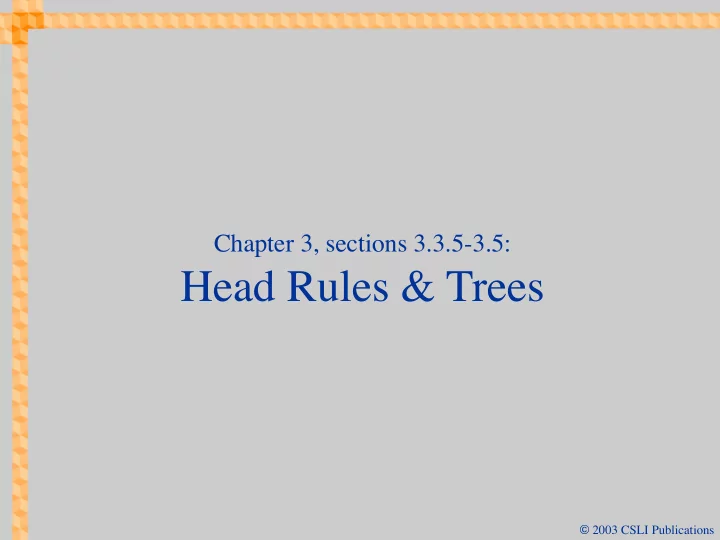

Chapter 3, sections 3.3.5-3.5: Head Rules & Trees 2003 CSLI Publications
Topics of Last Lecture • Distinctions among the world, models of the world, and descriptions of models • Typed feature structures as a way of modeling things, and of describing models • Combining feature structures used as descriptions • The beginnings of the linguistic type hierarchy 2003 CSLI Publications
A little more review phrase phrase HEAD HEAD noun noun NP = NOM = � � � � COMPS itr COMPS itr VAL VAL SPR + SPR − phrase phrase HEAD verb HEAD verb VP = S = � � � � COMPS itr COMPS itr VAL VAL SPR + SPR − 2003 CSLI Publications
The Type Hierarchy so far feature − structure pos expression val-cat [HEAD,VAL] [SPR,COMPS] word phrase agr-pos prep adj conj [AGR] noun det verb [AUX] 2003 CSLI Publications
Reformulating the Grammar Rules I Head-Complement Rule 1: phrase word � � � � → H COMPS itr COMPS itr VAL VAL SPR SPR − − Head Complement Rule 2: phrase word � � � � NP COMPS itr → H COMPS str VAL VAL SPR SPR − − Head Complement Rule 3: phrase word � � � � NP NP COMPS itr → H COMPS dtr VAL VAL SPR SPR − − 2003 CSLI Publications
Reformulating the Grammar Rules II Head-Specifier Rule 1: phrase phrase NP � � verb � H � � HEAD � COMPS itr → � � AGR 1 VAL HEAD AGR 1 SPR + � � SPR VAL − Head-Specifier Rule 2: phrase phrase HEAD noun � � → D COMPS itr H VAL � � SPR + VAL SPR − 2003 CSLI Publications
Reformulating the Grammar Rules III Non-Branching NP Rule word phrase HEAD noun � � COMPS itr → H VAL � � SPR + VAL SPR + Head-Modifier Rule phrase phrase � � → H PP COMPS itr � � VAL VAL SPR − SPR − Coordination Rule � � word 1 + 1 → 1 HEAD conj 2003 CSLI Publications
Advantages of the New Formulation • Subject-verb agreement is stipulated only once (where?) • Common properties of verbs with different valences are expressed by common features (for example?) • Parallelisms across phrase types are captured (for example?) 2003 CSLI Publications
Disadvantages of the New Formulation • We still have three head complement rules • We still have two head specifier rules • We only deal with three verb valences (which ones? what are some others?) • The non-branching rules don’t really do any empirical work • Others? 2003 CSLI Publications
Heads • Intuitive idea: A phrase typically contains a word that determines its most essential properties, including • where it occurs in larger phrases, and • what its internal structure is • This is called the head • The term “head” is used both for the head word in a phrase and for all the intermediate phrases containing that word • NB: Not all phrases have heads 2003 CSLI Publications
Formalizing the Notion of Head • Expressions have a feature HEAD • HEAD’s values are of type pos • For HEAD values of type agr-pos , HEAD’s value also includes the feature AGR • Well-formed trees are subject to the Head Feature Principle 2003 CSLI Publications
The Head Feature Principle • Intuitive idea: Key properties of phrases are shared with their heads • The HFP: In any headed phrase, the HEAD value of the mother and the head daughter must be identical. • Sometimes described in terms of properties “percolating up” or “filtering down”, but this is just metaphorical talk 2003 CSLI Publications
A Tree is Well-Formed if … • It and each subtree are licensed by a grammar rule or lexical entry • All general principles (like the HFP) are satisfied. • NB: Trees are part of our model of the language, so all their features have values (even though we will often be lazy and leave out the values irrelevant to our current point) 2003 CSLI Publications
Question: Do phrases that are not headed have HEAD features? 2003 CSLI Publications
phrase verb agr-cat HEAD AGR PER 3rd NUM pl val-cat VAL COMPS itr SPR + phrase phrase noun verb agr-cat agr-cat HEAD HEAD AGR PER 3rd AGR PER 3rd NUM pl NUM pl val-cat val-cat VAL COMPS itr VAL COMPS itr SPR + SPR − word word noun verb agr-cat agr-cat HEAD HEAD AGR PER 3rd AGR PER 3rd NUM pl NUM pl val-cat val-cat COMPS itr COMPS itr VAL VAL SPR + SPR − they swim 2003 CSLI Publications
A Question: Since the lexical entry for swim below has only [NUM pl] as the value of AGR, how did the tree on the previous slide get [PER 3rd] in the AGR of swim ? word verb � � HEAD � � NUM pl AGR swim , � � COMPS itr VAL SPR − 2003 CSLI Publications
Recommend
More recommend